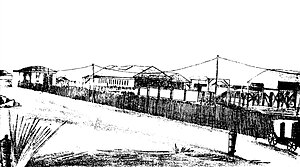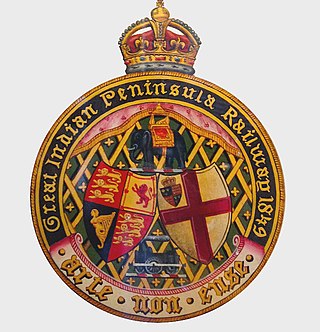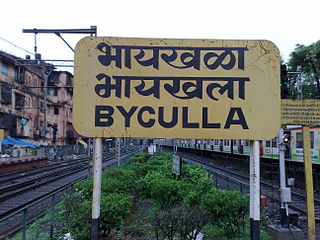The station
Built by the then Great Indian Peninsula Railway, this railway station takes its name from the nearby locality, Bori Bunder.
The station was a small one, with only a single pair of tracks, and had no platforms. The station had wooden buildings, and those from the earliest days of the station had been regarded as "temporary" by the Chief Engineer Berkeley as late as 1860. The location of the station near the sea, meant that the waves often lashed near the Terminus. [1] An Australian Newspaper Report however states that the function of the first train journey was held on a "neatly matted" platform, 300 ft in length, hence suggesting that the said platform was a ground level platform, or a temporary structure of some kind.
With the American Civil War, the Britain's demand for cotton was diverted from America to India. Bori Bunder station found itself as a 'dump yard' with cotton from over the country brought here, to be later transported to Britain through the seas. The station was 'overcrowded' with a lack of storage alternatives. Thereafter, large sheds and Godowns were constructed to protect the produce. A goods terminus was also later built at Wadi Bunder, to store firewood. The station had hence become considerable spacious by 1864. George Bradshaw had mentioned that the station was then a "commodious edifice" with well furnished reception rooms, and well planned for a "vast and extensive office". [2]
The station was renovated several times till the 1870s, when finally after 1877, it was demolished to pave way for the majestic Victoria Terminus.
The first train journey
On 16 April 1853, the Great Indian Peninsula Railway operated the first passenger train in India from Bori Bunder to Thane with 14 carriages and 400 passengers. The train which had three named locomotives, viz., Sindh, Sultan and Sahib, took off and embarked on an hour-and-fifteen-minute journey to Thane. [3] The journey covered a distance of 21 miles (34 km), formally heralding the birth of the Indian Railways. [4]
The official day of inauguration was nothing short of a grand celebration, with the day (16 April 1853) being declared a public holiday. The whole journey was planned to cover the 21 miles (34 km) between the Bori Bunder station to Tannah, and the ceremony took place at the starting point at the 19 acre site of the Bori Bunder station. For the occasion, the platform was neatly matted, and was screened on the western side by a white screen, against the rays of the sun, and the high north wind that was blowing the afternoon, carrying immense clouds of dust. The platform was also decorated by flags and cloths of various colours. There were 18 flags in the front of the platform, as reported by the Bombay Gazette with the prominent among them being the St George's ensign, later displaced by the Union Jack.
At 2 o' clock that afternoon, the invitees started to assemble at the terminus, and by 3 o' clock the invited Europeans and Natives were crowded on the platform. Captain Barr, and Mr. Roche, the Traffic Manager were the Masters of the Ceremony. At about 3 o' clock, they started allotting places to the ladies, after which, the men were asked to find their accommodations, so that by 3:15 p.m., few could be found on the platform. [5] One of the passengers on board, was the wife of Bombay's then governor (Lord Falkland), Lady Amelia Falkland.
The train itself was composed of 14 carriages (including the First, Second and Third Class) and supposedly pulled by 3 locomotives: Sindh, Sultan, and Sahib, out of which two were of the same type, the engines with the classification GIP-1, as per an exhibit at the CSMT Heritage gallery.
At 3:35 p.m, amidst a thunderous applause, a 21 gun salute was fired from the ramparts of the nearby Fort George, following which, the train carrying about 400 passengers, moved on towards its maiden official journey to Thane.
The train further stopped at Byculla, Sion, and Bhandup, finally stopping at Thane. [6] At Sion, the engine's water reserve was filled up, and its new wheels were greased.
The journey was completed in 57 mins, though the trial run conducted the previous year on 18 November 1852 took only 45 mins. [7] Tens of Thousands of 'natives' crowded around to witness the grand event; people climbed wall tops, branches of trees, and the masts of Arab Bungalows, windows, tops of temples and houses. In fact, when the train approached Thane, people crowded on the sides thickly for more than a mile, and had to be kept in control by the Ghat police.
After arriving at Thane, the attendees were provided with an immense tent, for a "cool retreat", and a "splendid tiffin" [8] There were then held speeches by the "gentlemen", with the Chief Engineer James John Berkeley too providing his own. In that speech, he celebrated the event, and praised all those who made the line possible, with a special mention to the native workers, whom he praised to have exceeded expectations, and stating about the docility, endurance and discipline of the native troops. The ceremony then ended at 6 o' clock that day. This was in the end, a successful event, one to be remembered.
The regular service of the train then started on Monday, 18 April 1853.
















